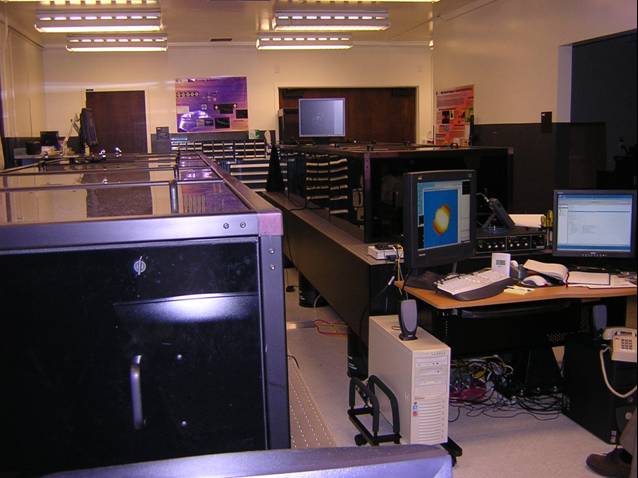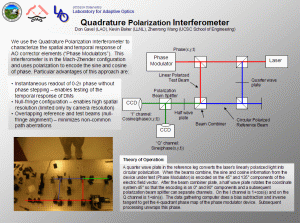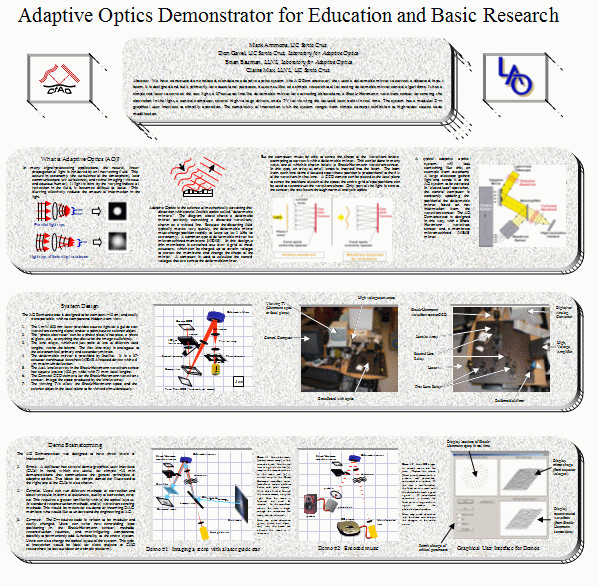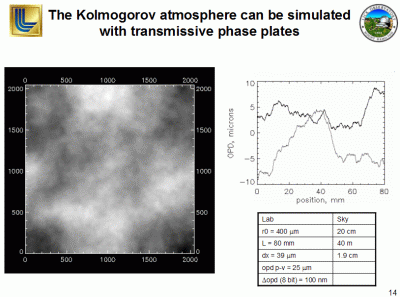|
Laboratory Facility
|
- 1900 sq ft in the in the
Thimann Laboratories Building in two separate
rooms
- Lab area clean to class 10,000
standards
- Class 100 cleanroom area
- Temperature control
- Light control
|

|
|
Optical Tables
|
- 18 x 4 ft granite optical table (ExAO
testbed)
- 6 x 6 ft granite optical table
(cleanroom/assembly/test area)
- 2 16 x 4 ft Newport optical tables (MCAO
testbed, wavefront sensing and control
experiments, interferometers)
|
Interferometers
|
- Phase-shifting Diffraction Interferometer
(PSDI) - ~0.2 nm rms absolute wavefront accuracy
over a 10-20 mm area - ExAO prototype
evaluation and calibration
- Zygo Fizeau Interferometer - 4 inch
aperture with 6 x zoom, 1000x1000 resolution,
4" window and flat with lambda/20
certification - general purpose optical
testing
- Veeco White-Light Interferometer -
- for testing MEMS devices
- Quadrature Polarization Interferometer (QPI) -
high speed (30 Hz) phase determination on 20 mm
square aperture in a Mach-Zehnder configuration -
used for testing transmissive optics
single-pass and the temporal response of spatial
light modulators
|

|
Deformable Mirrors
|
- 32 x 32 continuous face sheet MEMS device
from Boston Micromachines - going in to ShaneAO as the high-order DM.
- 2 52-actuator magnetic-actuated membrane
DMs from Alpao. One for the MCAO testbed, one going in to ShaneAO
as the woofer (low-order) DM.
- 4 768 x 768 pixel liquid crystal spatial
light modulators from Hamamatsu - surrogate DMs
for the MCAO testbed
- Some number of 37-element segmented MEMS devices from Iris AO -
for AO demonstration and laser beam wavefront correction.
Laser Guidestar Uplink AO
is an ongoing research effort at Lick Observatory.
- 1 36 element membrane DM from Aperture Optical Systems - for AO
demonstration and controls research
|

|
Detectors
|
- 3 1024 x 1024 Dalsa 1M30 cameras -
wavefront sensors for the MCAO testbed (up to 4
guidestars per camera)
- 2 additional 1024 x 1024 Dalsa 1M30 cameras
- wavefront sensing in the ExAO prototype
- 1K x 1K Science Grade CCD from Princeton
Instruments with E2V CCD47-10
chip - for far-field high-contrast measurements
on the ExAO testbed
- 2 Sci-Measure "Little-Joe" cameras with 80x80
Lincoln Labs CCD39 chip. One will be incorporated
as the tip/tilt sensor on ShaneAO.
- 1 Sci-Measure "Big-Joe" camera with 160x160
Lincoln Labs CCD66 chip - to be incorporated as the
wavefront sensor on ShaneAO.
|
|
Wavefront Aberration Plates
|
- Etched glass 150 x 150 mm area with
Kolmogorov spectrum, 40 micron features (4K x
4K), 8 bit resolution, 25 micron peak optical
path difference - for testing ExAO or MCAO
systems with simulated atmospheric turbulence -
we only have 2 of these now but plan to
replicate them at various peak optical path
specification for use as simulated atmospheric
layers.
- Acrylic spray on optical plastic. These are
round 4 to 6 inch plates with a random pattern
of aberrations roughly following a Kolmogorov
power law.
|

|
Lasers
|
- A 2-watt 532 nm short coherence laser for use in the PSDI interferometer.
- A 10 watt 589 nm Sodium Guidestar laser.
Based on fiber-amplifier technology, this laser is adjustable in spectral and pulse format
to enable optimal coupling to the sodium atoms.
This is now in the LAO cleanroom in preparation for being installed
at the Shane telescope in conjunction
with the new Shane telescope adaptive optics system, ShaneAO. This laser was developed
by a team at Lawrence Livermore National Laboratory under an R&D
grant from the CfAO.
|
|
Computing
|
- Hardy Quad 3.04 Gigahertz CPU with 8 GBy RAM, 4
MBytes cache - for real-time MCAO tomography
and wavefront control. This is sufficient
for 9 laser guidestars and 4 deformable mirrors
with a 5 Hz control loop update rate. CPU
idle time can be used for simulation
runs.
- Lightwave A 24-processor compute server running
Linux with IDL, Mathematica, Python, etc. - For running
compute intensive AO-project related calculations such as Fresnel wave-propagation
and laser guidestar sodium response physics.
|
|



